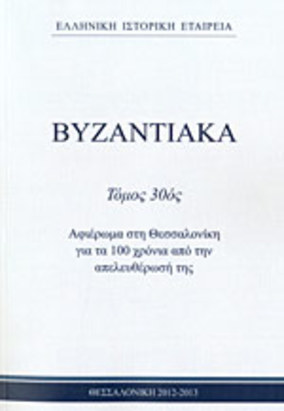Το διάταγμα που εξέδωσε ο χαλίφης al-Mutawakkil κατά των χριστιανών και των άλλων dhimmī το 235 μ.Ε. / 849-850 μ.Χ.
Part of : Βυζαντιακά ; No.30, 2012, pages 321-337
Issue:
Pages:
321-337
Parallel Title:
The decree that the caliph al-Mutawakkil issued against Christians and other dhimmī in A.H. 235 / A.D. 849-850
Section Title:
Αφιέρωμα στη Θεσσαλονίκη για τα 100 χρόνια από την απελευθέρωσή της. Ποικίλες συνεργασίες
Author:
Abstract:
This paper aims at discussing the structure and content of the decree issued by the caliph al-Mutawakkil against Christians and other dhimmī in A.H. 235 / A.D. 849-850. Τhe term dhimma used to designate the protection and security granted to members of other religions who lived within the Muslim society. There always was an indefinitely renewed contract through which the Muslim community accorded hospitality and protection to members of other revealed religions, on condition of their paying the agreed taxes and acknowledging the domination of Islam. The beneficiaries of the dhimma are called dhimmīs, and are collectively referred to as ahl al-dhimma or simply dhimma. The restrictions imposed by al-Mutawakkil on the protected communities (dhimmī), i.e. the non-Muslims of the caliphate, were first enacted by the caliph ‘Umar ibn ‘Abd al-‘Azīz and then by Hārån al-Rashīd. The protected peoples (dhimmī) living in Muslim society were mostly Jews, Christians and Sābians.The decree issued by the caliph al-Mutawakkil is preserved in al-Tabarīs work entitled Ta’rīkh al-rusul wa’l-mulūk. The ordinances of al-Mutawakkil’s decree entailed strict conditions on Christians for eating, appearance and outfit in order to distinguish them from Muslims. Al-Tabarī also adds further measures taken against the dhimmī peoples as follows: The protected peoples could not renovate their places of worship or display publicly their religious symbols or hold religious processions. Moreover, they could not be employed in administrative positions or other official functions, “in which their authority would be exercised over Muslims”. Also, they could not send their children to Muslim elementary schools or being taught by Muslim teachers. These strict orders imposed by al-Mutawakkil concerned even the graves of dhimmī, which should be at the same level with the ground so as not to stand out from the graves of Muslims.As we know, dhimmī lived under the Muslim rule, since the advent of Islam. It appears that the caliph al-Mutawakkil had political reasons to issue this decree. Having realized that the policy favouring the Mu#tazilites was not popular, he attempted to change policy. It seems that most of his measures primarily aimed at protecting the Muslims with a traditional bent and then the members of other religions by enacting restrictions discriminating between them. Most of these measures refer back to the terms of the treaties signed between Muslims and non-Muslims during the conquests (futåÈ) in the early 7th century. And as then, such ordinances aimed at protecting the identities of the Muslims against the new circumstances they found themselves. Now, it is clear that the primary aim was the protection of the Muslims and the Muslim community and then the control of other communities that lived within the Muslim society.
Subject:
Subject (LC):
Notes:
Περιέχει σημειώσεις




